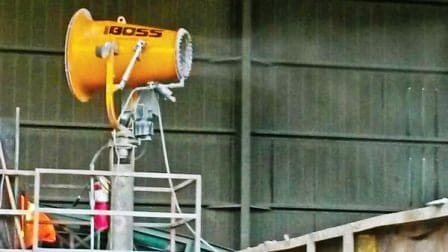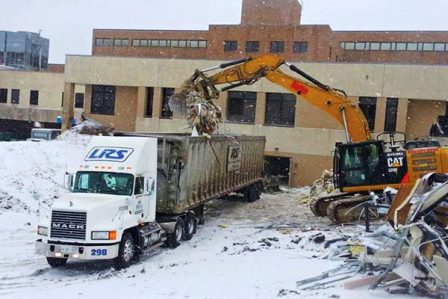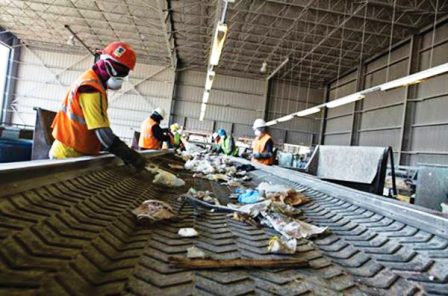With environmental stewardship as a key component of Lakeshore Recycling Systems’ operating philosophy, company officials wanted to take a proactive approach to dust suppression.
By Mike Lewis
Chicago is currently going through a building boom, sparked in part by the addition of 19 new hotels to its skyline—more than 3,000 rooms—slated to open by 2016. The increase isn’t limited to hospitality, as all categories of construction have seen growth, from single-family residential to commercial and mixed-use. One result of the uptick is a higher demand for local construction and demolition (C&D) recyclers.
In 2012, two mid-sized Chicagoland recycling companies merged to become Lakeshore Recycling Systems (LRS). The company has since acquired two more locations, allowing the firm to raise its production to 1.5 million tons of debris processed annually. LRS is now the largest provider of construction material disposal containers in the Chicago area.
Along with that increased volume comes a greater amount of dust created at the recycling centers, which has the potential to affect air quality and worker safety. With environmental stewardship as a key component of the company’s operating philosophy, company officials wanted to take a proactive approach to dust suppression. “Although we have residential pickup, our main source of material is from C&D projects,” explained Mark Sredin, longtime Production Manager for LRS. “We receive concrete, wood, drywall, cardboard, glass and paper. All of these materials create their own particulates, along with the years of dust they may have collected prior to demolition.”
Dusty Process
Sales of raw separated material contribute to a large portion of the company’s revenue, along with dumping fees and container rentals/transport. In most cases, the company drops off one or more containers at a demolition site, where it’s up to the contractors to control any fugitive material and dust. When LRS picks up the full container, it’s covered with a tarp to contain dust during transport and hauled to one of the three locations. In all, hundreds of vehicles—including the 55 company-owned waste collection trucks—arrive daily to deliver recyclable materials from more than 6,000 commercial and municipal customers. Each incoming vehicle is weighed upon entry and exit to determine its disposal fee.

The recycling process begins when a front loader pushes the bulk material into a 25,000 square foot, three-walled, open-air structure. The debris is loaded onto a tipping floor leading to a large steel screen with 2-inch openings. Industrial vibrators shake the screen—set at a 7-degree slope—moving the material slowly down the incline. Small debris (dirt and aggregate) falls through the holes and onto a lower conveyor belt to be transported to the landfill, whereas the remaining larger debris is conveyed to a sorting area.
Once separated, the screened debris drops onto a 5-foot wide conveyor belt and is then transferred onto another curved conveyor feeding the large material picking line to be sorted. Wood, glass, steel, cardboard, brick and concrete are removed. Sorted material is then sold to various vendors for repurposing. Sredin pointed out that sorting the recyclable material also involves a staff of people standing at a conveyor belt evaluating and separating the debris, then placing larger pieces in bins. This requires a safe work area, with dry floors and adequate air quality. With all of the mechanical agitation, the process creates large volumes of fugitive dust and a need for dust suppression.
Dust Suppression Techniques
LRS started with a large sprinkler system for dust management, which is common in many bulk handling applications. But Sredin and his team soon realized that it wasn’t adequate. “It saturated the material and caused pooling water under the sprayer and around heavy machinery,” he recalled. “It not only made the material hard to handle, but it also didn’t address the dust issue.”

Company officials performed a detailed search in trade magazines and online for a better solution, eventually contacting Dust Control Technology (Peoria, IL) to investigate the company’s family of atomized mist dust suppression units. Dust Control Technology is a global leader in dust and odor control solutions for mining, rock and aggregate processing, demolition, recycling and scrap processing. The company’s DustBoss® product line uses atomized mist technology propelled by powerful fans to capture fugitive particles over a wide area. The automated units use less water than hoses and sprinklers, with lower labor or maintenance costs, allowing some customers to realize payback in less than six months and netting an annual cost savings of more than $50,000.
Impressed by what they learned, the firm purchased its first DustBoss® DB-30 for the California Avenue location in Chicago, with the intention of replacing the ineffective sprinkler system. Initial testing was successful and operators reported a substantial improvement in air quality along the debris sorting line, as well as dramatically reduced pooling and runoff. Based on that experience, the company has now installed a unit in each of its facilities, creating a safer and more efficient workplace for its more than 350 employees.
Sredin’s team chose the DB-30 because of its rugged construction and long warrantee. “We initially tried it in multiple positions and areas in the plant,” he continued. “Due to its long range, we found that mounting the DustBoss on the deck over the main conveyor and away from the picking line was the best way to suppress it before it reached employees, letting the mist cover the rest of the conveyor system.”
The DB-30 uses a 7.5 HP fan delivering 9,200 CFM (260.50 CMM) to project a 100-foot cone of dust-trapping mist. With an adjustable throw angle of 0º to 50° in height, the unit has a coverage area of up to 31,000 square feet (2,880 square meters) when equipped with optional 359° oscillation.
A three-sided building poses a unique challenge. Even though it is an enclosed space, operators still have to contend with the elements such as wind, rain and severely low temperatures. According to Sredin, swirling wind within the complex is addressed by merely adjusting the unit’s spray angle. “Our DustBoss is on all day, every day. When it rains or snows, there’s less dust, so we simply turn off the atomizer and allow the strong fan to clear the air. It’s very versatile,” he said.

The Slipstream Effect
Sprinklers are used by many industries for dust suppression, but they have been proven to be ineffective unless material is totally saturated prior to any disturbance. The primary reason is that a water droplet from a sprinkler is typically between 2,000 and 6,000 microns in size. In contrast, dust particles are generally 50 to 100 microns in size. Due to the larger mass of the droplet, two issues can arise that prevent effective dust suppression.
First, the impact of the droplet on settled dust can actually cause the dust to become airborne. After being set aloft, fugitive dust particles are carried by air currents, becoming subject to the second issue: the “slipstream effect.” This happens when the size and velocity of the sprinkler droplet affect the airflow around it. The large droplet approaches airborne particles, but the airflow deflects the particles without a collision, preventing effective dust management.
To overcome this tendency, the atomized mist emitted from the DB-30 is made up of millions of droplets between 50 and 200 microns in size. The unit injects 100 PSI (6.89 BAR) of water through a brass ring equipped with atomizing nozzles, creating miniscule droplets that are propelled by the fan and travel with the dust, colliding with particles to capture them and pull them to the ground. “The moment we turned it on, we noticed a difference in air quality,” Sredin said. “The mist took the particles right out of the air. We were surprised at just how well it worked.”
Pooling and Runoff
Pooling and runoff are among the biggest concerns when using dust suppression, especially indoors or near walkways. According to the U.S. Department of Labor, “Slips, trips, and falls constitute the majority of general industry accidents. They cause 15 percent of all accidental deaths, and are second only to motor vehicles as a cause of fatalities.”1
While large sprinklers can apply 500 gallons per minute (GPM) or more, the DB-30 uses just 3 GPM. “Even running the atomizer all day long, there is no pooling,” Sredin said. “Also, our water bill has gone down considerably.”
When LRS acquired its Southside Chicago location, it was a smaller competitor with a similar process. “For dust suppression they were using a garden hose with a spray nozzle you would buy at the hardware store,” Sredin explained. “It wasn’t doing anything to the dust, and the floor was wet all the time. We immediately brought in the DB-30 and mounted it in a fashion similar to our primary facility. The safer workplace and higher air quality was an instant morale booster for everyone on the sorting line.”
In 2014, the company purchased Heartland Recycling in Forest View, IL, which had installed three small atomizers that didn’t contain adequate fans. “The mist just fell to the floor and pooled, without capturing much dust,” Sredin observed. “I think the previous owners had the right idea, but with low coverage and no oscillation, the units didn’t do much. We installed one DB-30 to replace all three units and solved both the pooling and the dust problems at the same time.”
Recycling Chicago
The City of Chicago, in partnership with LRS, has concentrated on recycling programs involving C&D materials by offering incentives to businesses that reduce service charges for keeping materials out of landfills. According to Chicago officials, “C&D debris accounts for 30 percent of all solid waste produced (in the Chicagoland area).”
The city’s incentive plan has increased the volume of recycled C&D debris above that of residential materials. It now accounts for 85 percent of all recycled material, with approximately 500,000 tons recycled each year.2 A large percentage of that is processed through LRS, making it Chicago’s leading recycling and waste diversion services provider.
A company spokesman says LRS will meet increased production expectations of C&D material as the construction market continues its rebound, predicting that it will stay on pace for its expansion with gradually increasing volumes of recyclable waste. According to Sredin, with each new facility, there is anticipation of dust suppression using a DustBoss product. “They’ve done a great job, exceeding all of our expectations,” he concluded.
For more information, call (800) 707-2204, e-mail [email protected] or visit www.dustboss.com.
Notes
Staff, United States Department of Labor, Walking and Working Surfaces, 06/2014. www.osha.gov/SLTC/walkingworkingsurfaces.
Staff, City of Chicago, Construction and Demolition Debris Recycling, 08/2014. www.cityofchicago.org/city/en/depts/cdph/supp_info/environmental_permitsandregulation/construction_anddemolitiondebrisrecycling.html.
